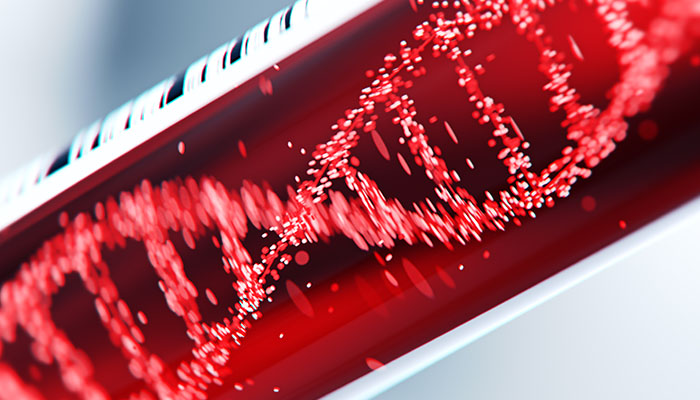HOW CAN WE HELP YOU? Call 1-800-TRY-CHOP
In This Section
First Potentially Curative Gene Therapy for Beta Thalassemia: Q&A with Janet Kwiatkowski, MD, MSCE

CHOP was a leading study site in the clinical trials that led to the FDA approval of the first potentially curative gene therapy for the treatment of beta thalassemia.
Editor’s Note: After 10 years of clinical research, the efforts of Children’s Hospital of Philadelphia investigators and others are coming to fruition with the Food and Drug Administration approval of beti-cel (Zynteglo®), the first potentially curative gene therapy for people who require regular red blood cell transfusions to treat beta thalassemia. CHOP will be one of a few Qualified Treatment Centers offering the therapy manufactured by bluebird bio Inc., which estimates there are 1,300 to 1,500 individuals with transfusion-dependent beta thalassemia in the United States.
As the director of CHOP’s Thalassemia Center, Janet Kwiatkowski, MD, MSCE, was the CHOP lead investigator for the three clinical trials that led to beti-cel’s approval, and overall coordinating investigator for one of the studies. In this Q&A, Dr. Kwiatkowski offers her insight into this new gene therapy and what it can mean for patients. But first, a message from Alexis Thompson, MD, MPH, chief of the Division of Hematology.
“There is a deep unmet need for a potentially curative treatment option for patients with transfusion-dependent beta thalassemia, whose quality of life is profoundly impacted by both the disease and the current standard of care,” said Dr. Thompson, who was a lead investigator of the phase 3 clinical trials and presented before the FDA Advisory Committee ahead of approval. “As a lead investigator in the clinical trials that led to beti-cel’s approval, I am thrilled that the FDA has approved this treatment, which has the potential to vastly improve patients’ lives.”
Dr. Kwiatkowski, would you please give us an overview of beta thalassemia?
Thalassemia is an inherited disorder that affects the production of normal hemoglobin, a type of protein in red blood cells that carries oxygen to tissues throughout the body. Beta thalassemia is caused by mutations in the beta chain of the hemoglobin molecule. There’s one beta chain gene on each number 11 chromosome, for a total of two. How these genes are altered determines the specific type of beta thalassemia in a child.
The most severe form of the disease, called transfusion-dependent beta thalassemia or beta thalassemia major, involves mutations of both copies of the hemoglobin beta chain gene. These patients experience severe anemia, require lifelong blood transfusions typically every three to four weeks, close monitoring for complications, and treatment for iron overload from these chronic blood transfusions.
What is important about the findings of the clinical trials?
The FDA approval was based on clinical trial data from multiple study sites, including CHOP. The data showed that 89% of patients treated with this one-time gene therapy during the three trials were able to stop blood transfusions while maintaining hemoglobin levels of at least 9 grams per deciliter. The benefits extended from patients ages 4 to 34 with beta globin mutations ranging from milder to more severe.
How does this treatment work?
The one-time gene therapy is designed to treat the underlying genetic cause of beta thalassemia in adult and pediatric patients who require regular red blood cell transfusions. It works by adding functional copies of a modified form of the beta-globin gene into a patient’s own hematopoietic stem cells to allow them to make normal to near normal levels of total hemoglobin without regular red blood cell transfusions. The functional beta-globin gene is added into a patient’s cells ex-vivo (outside of the body), and then infused back into the patient after the patient receives chemotherapy to empty out the old, untreated blood stem cells. The process is comprised of several steps that could take place over the course of several months.

CHOP will be one of a few Qualified Treatment Centers offering the first potentially curative gene therapy for people who require regular red blood cell transfusions to treat beta thalassemia.
How does this treatment compare to currently available treatments for patients?
This treatment is a potential game changer for patients who have required regular red blood transfusions to manage their disease, an intense treatment burden that comes with its own risks. This is a treatment that worked in 89% of patients, enabling them to discontinue transfusions. And it worked in both adults and children.
A problem with an allogeneic transplant using donor stem cells, which is the current available curative treatment, is that not all patients have an appropriate donor. But for gene therapy, the patient is the donor, so everybody will have a donor. Another problem is that outcomes for allogeneic transplant traditionally have been much better in younger children compared with adolescents and adults. But with this gene therapy, the outcomes have been similar in adults and kids. So I think it will greatly expand access for those two reasons.
Above all, it is important for patients to have choices about their treatment. This gene therapy offers a potentially curative option that far surpassed what we were expecting in terms of effectiveness.
What makes CHOP an ideal Qualified Treatment Center for patients to receive this therapy?
First is our experience with gene therapy. This FDA approval marks the fourth cell and gene therapy offered at CHOP, which has stood out as a pioneer in developing, studying, and administering these breakthrough therapies. From the first FDA-approved gene therapy to the first FDA-approved gene therapy for a genetic disease, CHOP has been at the forefront of cell and gene therapy discoveries that have transformed patients’ lives.
Also, this approval caps off nearly a decade of clinical research of beti-cel at CHOP, where screening of the patients and access to the therapy was centralized and streamlined through our Sickle Cell and Red Cell Disorders Curative Therapy Center (CuRED). CuRED is a unique collaboration between the Division of Hematology and the Cell Therapy and Transplant Section (CTTS) transplant team. The program provides integrated and coordinated care for patients with red blood cell disorders, combining appointments with hematologists, stem cell transplanters, psychologists, social workers, fertility preservationists, and other specialists at a single visit. A key part of CuRED’s role at CHOP will involve evaluating and counseling patients with beta thalassemia on whether gene therapy is an appropriate treatment option.
As part of this complex and highly collaborative effort, CTTS facilitates collection of patient cells and cell transfer for manufacturing. The cells are then returned to the Cell and Gene Therapy Lab. The patient is admitted to the transplant service to undergo the preparative chemotherapy, administration of the modified cells, and inpatient post-transplant care.
I am thrilled that CHOP’s Thalassemia Center, CuRED team, and CTTS transplant team will be able to provide this treatment to those patients for whom it is the best option.


